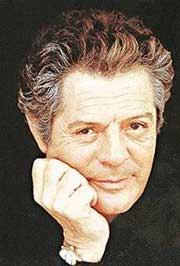
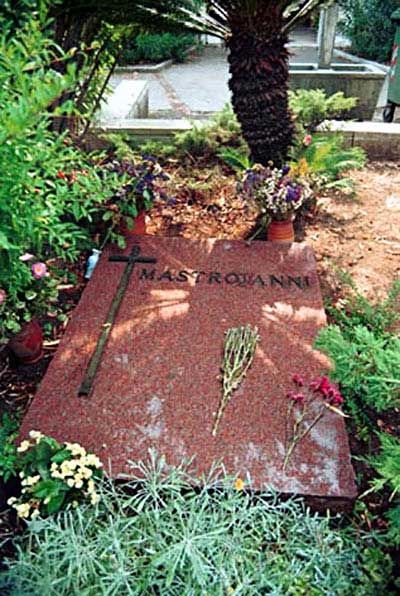
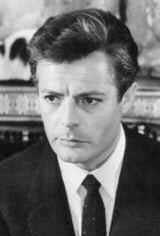
Year 1996
Year 2005 ....
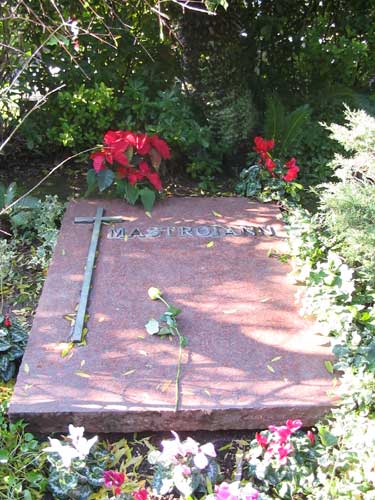


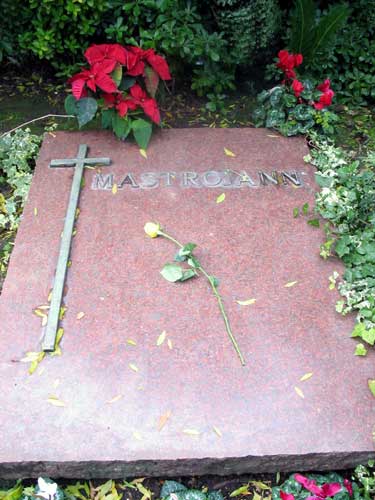

The premier Italian actor of the postwar era, Marcello Mastroianni was among
the most popular international stars in movie history. A speculative, almost
introverted screen presence, he was the perfect foil for the arid, often
puzzling films of directors like Michelangelo Antonioni and Federico
Fellini, with whom he achieved some of his greatest success.
Born September 28, 1924 in Fontana Liri, Italy, Mastroianni worked in Rome
as a draughtsman during World War II. Towards the close of the conflict he
was captured by the Nazis and exiled to a labor camp in northern Germany,
but he managed to escape and subsequently flee to Venice, where he spent the
remainder of the war in hiding. Upon returning to Rome in 1945, Mastroianni
accepted an accounting position with Eagle Lion (Rank) Films, and in his
spare hours performed with a local drama troupe, earning raves for an
appearance in Angelica which brought him to the attention of director
Luchino Visconti, who subsequently cast him in his production of As You Like
It. Mastroianni became a regular member of Visconti's company and starred in
dramas ranging from A Streetcar Named Desire to Death of a Salesman to Uncle
Vanya. In 1947 he made his film debut in I Miserabli but did not reappear
again onscreen for two more years.
Although Mastroianni enjoyed a successful and prolific motion-picture career
from 1949 onward, the films he made in his earliest days as a screen actor
were almost exclusively minor efforts, rarely screened outside of Italy. In
1955 he co-starred with Vittorio De Sica and Sophia Loren -- an actress with
whom he would frequently be paired in the years to come -- in Alessandro
Blasetti's comedy Peccato che Sia una Canaglia and later worked with
director Mario Monicelli on Padri e Figli. Still, for the most part both the
casts and crews of his projects were undistinguished, and he remained an
unknown outside of his native land. However, in 1957 Mastroianni reunited
with Visconti for Le Notti Bianche, a picture which the actor later noted as
a film that re-ignited his waning interest in the performing process. He
next appeared as a supporting player in Monicelli's classic crime caper I
Soliti Ignot, and for the first time he enjoyed success in the overseas
market. However, his international breakthrough was Fellini's 1960
masterpiece, La Dolce Vita; a long, enigmatic exposé of the lives of Italy's
Via Veneto set (Rome's wealthy socialites and partygoers), the picture was a
global smash, and star Mastroianni, portraying a jaded, disillusioned gossip
columnist, became a worldwide success story.
Mastroianni's next major role was in Antonioni's 1961 effort La Notte, where
again his distanced, expressionless demeanor fit perfectly into the film's
air of alienation and remote emotionality. It was a more assured Mastroianni
who next resurfaced in Pietro Germi's Divorzio all'Italiana, a black comedy
which was an award-winning box-office smash in Italy. It also proved to be a
major hit on the international arthouse circuit, where the actor won the
British Film Academy "Best Foreign Actor" award. The 1962 Louis Malle-helmed
La Vie Privée, in which he co-starred with Brigitte Bardot, was a success as
well. Along with the great Jean-Paul Belmondo, Mastroianni had emerged as
the most in-demand actor on the European continent, commanding fees upwards
of 100 million lire per film and working with Italy's most noted filmmakers.
For 1963's masterful Otto e Mezzo, he reteamed with Fellini, and in the same
year's I Compagni he reunited with Monicelli. Under the supervision of
producer Carlo Ponti, Mastroianni and Sophia Loren -- Ponti's wife -- paired
with director De Sica in 1963's Ieri, Oggi, Domani; the same principals also
tackled 1964's Matrimonio all'Italiana, which like its predecessor was a hit
overseas.
Sans Loren, Mastroianni continued appearing in Ponti productions, including
1965's Oggi Domani Dopodomani and La Decima Vittima, but without his
alluring co-star the actor's international stock plummeted. He also appeared
in the 1966 American television production The Poppy Is Also a Flower,
followed by the odd Spara Forte piu Forte Non Capisco with Raquel Welch.
Mastroianni quickly returned to Fellini's stable to begin work on the
long-planned Il Viaggio di G. Mastorna. However, disagreements between the
director and producer Dino De Laurentiis forced Fellini to walk out on the
project prior to production, leaving Mastroianni to star in Visconti's 1967
Camus adaptation Lo Straniero. He next travelled to Britain to star in
Diamonds for Breakfast, the first of his English-language films in which his
performance was not overdubbed. De Sica joined him behind the camera for the
1969 MGM production A Time for Lovers, while John Boorman helmed 1970's Leo
the Last. None of these pictures proved successful, however, and Mastroianni
returned to the comforts of Italy for his next several projects, including
1970's Fellini's Roma, before starring in Roman Polanski's 1973 feature What?.
He also appeared in a number of pictures with his offscreen paramour
Catherine Deneuve.
After several critical and commercial disappointments, Mastroianni scored
with the Taviani brothers' 1975 historical drama Allonsanfan. That same year,
he successfully reunited with Loren in La Pupa del Gangster. Still, while he
remained a highly prolific performer, appearing in several films annually
during the late 1970s and early 1980s, few of his projects managed to
penetrate the international market; too many disappointing efforts had
dimmed Mastroianni's stardom, and those movies that did expand into the
worldwide market were primarily those attached to a renowned filmmaker (as
was the case with Fellini's 1981 La Città delle donne and 1986's Ginger e
Fred). For 1987's Oci Ciornie, he earned honors from the jury at the Cannes
Film Festival, and later won an Academy Award nomination. Although now in
his early 60s, Mastroianni did not begin to decrease his workload. While the
majority of his foreign films did not surface in English-language markets --
the exception being Maria Luisa Bemberg's bizarre De Eso No Se Habla, in
which he portrayed a wealthy sophisticate who falls in love with a dwarf --
in 1993 he appeared in Robert Altman's star-studded Ready-to-Wear, sparring
one last time with Loren. After completing work on Raul Ruiz's acclaimed
Trois vies et une seule mort (Three Lives and Only One Death), Mastroianni
died in Paris on December 19, 1996; he was 72.







